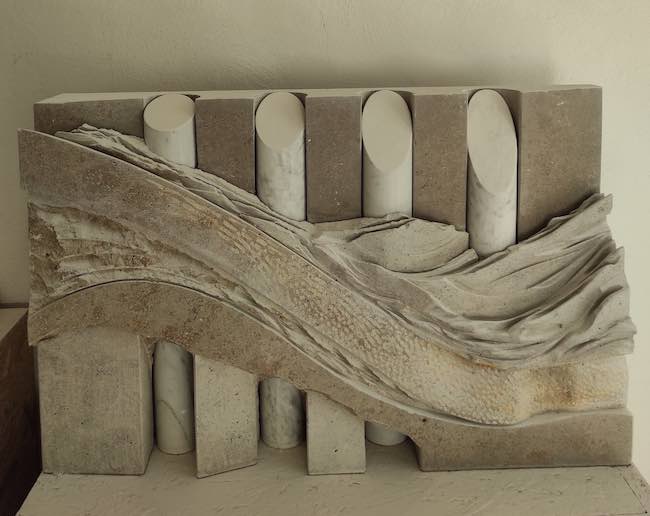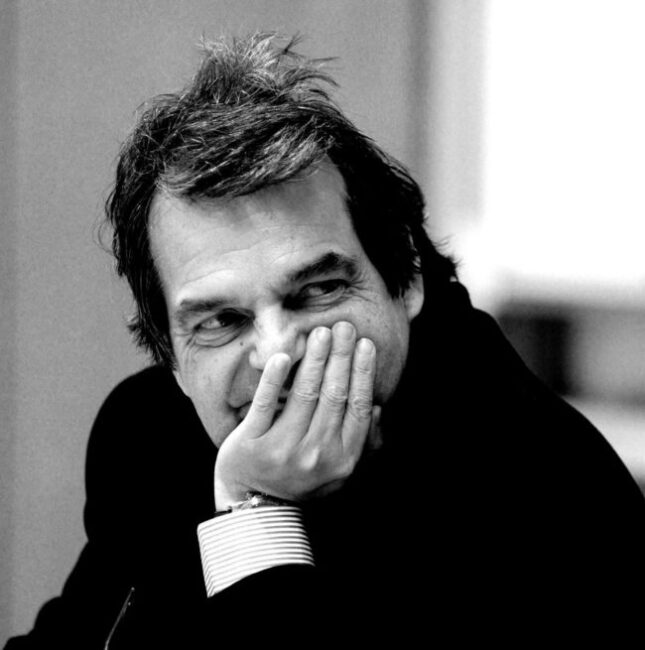La lavorazione dei materiali duri ha costituito sempre una sfida per gli artisti di ogni epoca poiché forgiare e plasmare superfici incredibilmente solide per dare loro una forma impensata osservando i blocchi originari, ha dato modo ai maestri del passato di rivelare il loro innegabile talento. Con il passaggio verso l’era moderna e l’avvento di movimenti meno figurativi e più concettuali, la scultura si è adattata ai nuovi linguaggi e ha trovato nuove dimensioni e forme ugualmente affascinanti e più al passo con i tempi. L’artista di cui vi parlerò oggi traccia un proprio percorso ben definito e riconoscibile nel mondo della scultura contemporanea.
Quando agli inizi del Novecento tutto il mondo artistico fu scosso dal vento di rinnovamento che determinò il distacco dalle regole e dalle convenzioni classiche di inseguimento dell’armonia e della perfezione delle forme legate alla riproduzione della realtà osservata, tutte le tecniche artistiche scelsero di adattarsi al nuovo concetto di rappresentazione creativa pur associandosi agli stili più affini a quelli del singolo artista; la scultura a sua volta si adeguò al cambiamento non solo mostrando un nuovo volto dei materiali tradizionali come il marmo, il travertino, il bronzo, il legno e il ferro, ma anche introducendo nuovi elementi materici come il vetro, il tessuto, il cemento, la sabbia. L’effetto fu sorprendente proprio perché in precedenza le forme a cui lo sguardo era abituato erano completamente differenti, più tese alla fedele riproduzione dell’osservato e meno implicite e interpretative. Tra i maggiori nomi della scultura internazionale del Ventesimo secolo non si può non citare Umberto Boccioni che con la sua Forme uniche della continuità nello spazio, eseguita in bronzo, determinò un vero e proprio manifesto del suo movimento; anche Max Ernst, grande esponente del Surrealismo, diede vita a sculture di grandi dimensioni in bronzo e in pietra, in cui emerge la struttura totemica, legata al primitivismo, in cui le figure antropomorfe assumevano un aspetto a volte inquietante, altre invece quasi rassicurante nella loro engimaticità. Giorgio De Chirico, padre fondatore della Metafisica, dedicò tutte le sculture ai celeberrimi manichini che contraddistinguevano anche le sue tele, rappresentando così il mistero di un’umanità privata della sua identità se non restando aggrappata a un passato che ha costituito le basi imprescindibili per la sua crescita. E ancora Alberto Giacometti le cui figure sottili e apparentemente fragili raccontavano la precarietà dell’essere umano in un periodo, quello della seconda guerra mondiale, in cui ogni certezza, ogni sicurezza era annientata dalla cruda realtà. Non si può parlare di scultura senza citare Arnaldo Pomodoro, le cui sfere racchiudono in sé il mistero insito dentro le cose evidenziato proprio dalla tendenza dell’artista a generare profonde fenditure per scoprire i meccanismi interni che restano costantemente inesplorati.
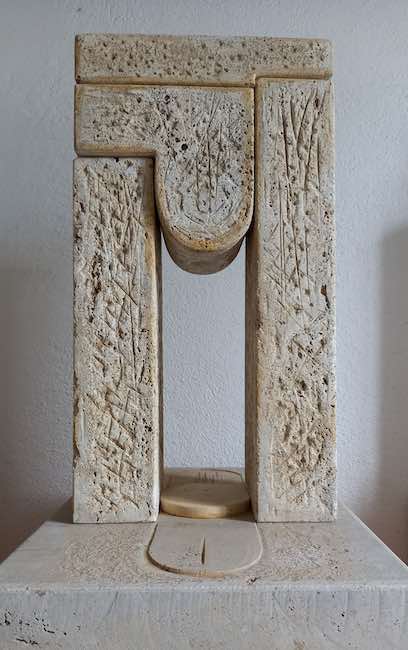
Lo scultore toscano Riccardo Grazzi si avvicina alla Metafisica con un approccio differente da quello di Giorgio De Chirico, poiché in lui ciò che conta è riprodurre lo spazio, la geometricità di dettagli di edifici, le porte, che rappresentano la spontanea tendenza umana alla scoperta, al voler guardare oltre, che sia la contingenza presente o un più filosofico sguardo verso l’incomprensibile o inconoscibile; dunque da un lato la curiosità innata, dall’altro la profondità di un’esigenza mentale, in entrambi i casi le sculture di Grazzi hanno il medesimo potere delle immagini pittoriche di De Chirico e di Magritte di indurre l’osservatore a riflettere sui limiti della condizione umana, limiti che però sembrano valicabili, potenzialmente oltrepassabili in virtù della capacità stessa dell’uomo di interrogarsi ed esplorare. Il materiale che predilige è il travertino accompagnato a volte dall’acciaio, altre dal legno, altre ancora dal marmo per misurarsi con superfici di consistenza diversa ma in grado di interagire divenendo l’una amplificatore dell’altra in un dialogo funzionale al risultato finale, quell’immagine silenziosa e suggestiva in cui i pieni si alternano ai vuoti che costituiscono l’essenza stessa dell’opera finale.
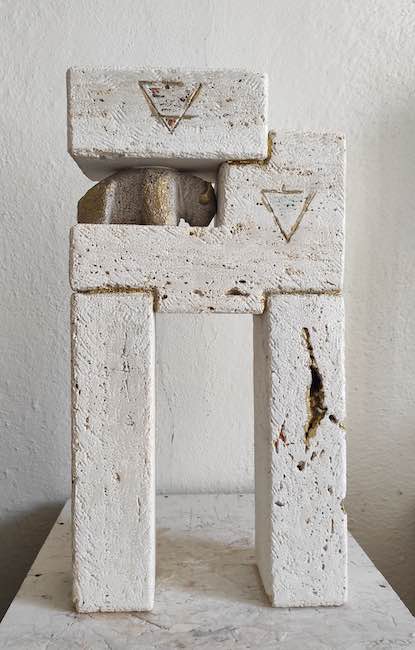
Sì perché è esattamente lo spazio a indurre l’osservatore a desiderare di oltrepassare la soglia, metafora della conoscenza, dell’incognita, dell’inconosciuto che però si rende possibile, accessibile esattamente per quel varco tra solidità e immobilità delle strutture e l’ariosità dell’apertura, che costituisce un’opportunità di scoperta, di sguardo futuro, di coraggio di andare oltre senza lasciarsi fermare dalle paure. I portali di Grazzi possono anche diventare un’allegoria della necessità del restare attaccati al passato poiché costituente la radice dalla quale poi far crescere i solidi rami che danno corpo al presente, senza che però quello stesso punto di partenza diventi un limite all’evoluzione e alla crescita che possono verificarsi solo con il coraggio di superare i confini del mondo conosciuto, spingendosi al di là di quelle colonne avvicinabili per significato alle solide certezze che troppo spesso si trasformano in gabbie.
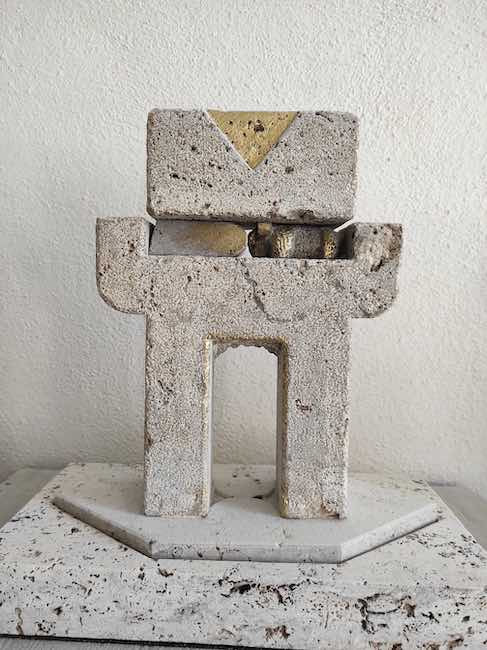
L’elemento metafisico emerge non solo nel significato profondo delle sculture di Riccardo Grazzi bensì anche dagli elementi che entrano a far parte dell’opera, come enigmatiche strutture coniche, le sfere, le scale che sembrano invitare l’osservatore a compiere quel percorso di salita che è di fatto la scelta di oltrepassare la soglia dei propri stessi limiti.
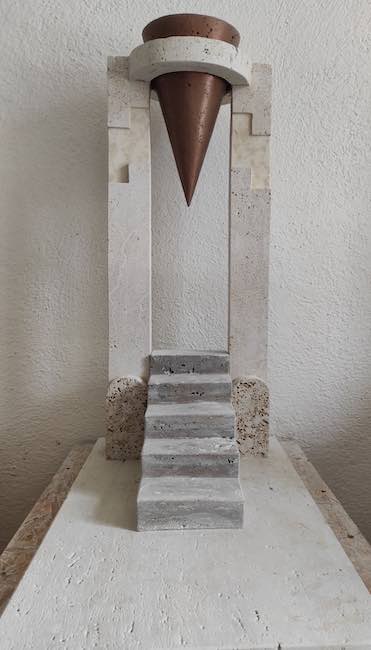
L’opera Portale del 1995 è emblematico di questo invito, dell’innata esigenza dell’uomo di vincere gli ostacoli solo però se non si lascia fermare o intimorire dal rischio dell’incognita, che spesso invece è una svolta positiva; la struttura in travertino sorregge il cono che la sovrasta enfatizzando l’equilibrio tra invito, quello delle scale che sembrano agevolare la salita, e la minaccia di dover passare per quella punta acuminata se si vuole andare oltre. L’indecisione e il timore spingerebbero l’individuo a restare immobile ma sarà solo in virtù della temerarietà che sarà possibile realizzare che in fondo quell’elemento è solidamente sorretto, non può scivolare e dunque è solo un rischio apparente.
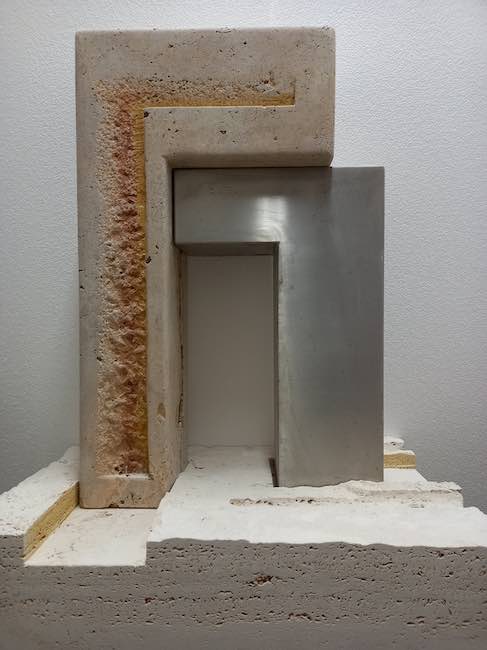
In Portale del 2008 invece lo spazio è chiuso, non conduce a nulla se non a un punto cieco che racconta l’uomo contemporaneo il quale crede di andare costantemente verso qualcosa trovandosi invece fermo, o forse sarebbe meglio dire incastrato, nelle sue convinzioni limitanti. In quest’opera lo spazio è solo quello esterno, quasi un suggerimento di Grazzi che se non è possibile passare in mezzo a un ostacolo, abbattere un muro, esiste sempre la possibilità di girare intorno e scoprire ciò che diversamente non sarebbe mai visto se quell’ostacolo determinasse una rinuncia.
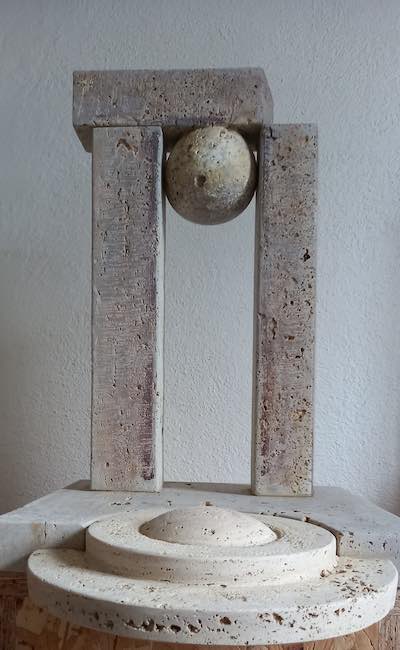
E ancora nell’affascinante Portale del sole, del 2007, l’artista pone l’astro in riflesso, la sua immagine infatti è situata sotto l’architrave ma anche nello spazio antistante all’apertura della porta, come se in qualche modo l’andare verso lo spazio fosse un modo per avvicinarsi alla luminosità e al calore, mentre il restare in contemplazione permetterebbe di osservare da spettatore la rifrazione della sua luce, di non lasciarsi davvero avvolgere dal beneficio di vivere le emozioni nella realtà, con tutto il loro calore, bensì restando in disparte a osservare qualcosa di più intenso vissuto da altri. Eppure il portale svetta maestoso sullo spazio antistante, sembra volersi focalizzare su quel contrasto illusorio in cui il riflesso appare persino più affascinante dell’astro originale, sottolineando così ancora una volta i paradossi della società moderna in cui si tende a dare più rilevanza alla forma piuttosto che alla sostanza, in cui l’immagine è più importante, più allettante dell’essenza, inducendo pertanto l’individuo a inseguire ciò che è effimero fermando pertanto la vera conoscenza, la reale evoluzione che permette di giungere a un gradino più alto.
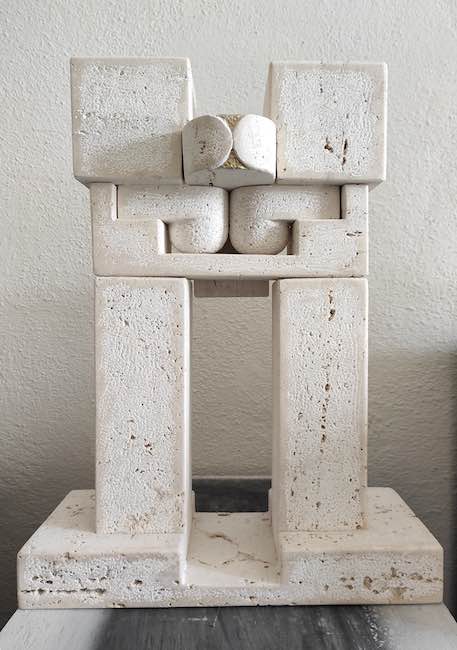
Infatti in Portale del 2020, l’annus horribilis del Ventunesimo secolo, Grazzi sembra riavvicinarsi al Classicismo, tende quasi la mano ai capitelli dorici delle colonne greche proprio perché in un periodo in cui tutto sembrava essere annullato, le certezze sovvertite, la libertà irrimediabilmente compromessa, l’unico appiglio sembrava essere il passato più antico, quello che è sopraggiunto a noi malgrado le rivoluzioni, il passare del tempo, i cambiamenti. Riccardo Grazzi, artista da sempre, ha al suo attivo importantissime mostre collettive e personali su tutto il territorio nazionale, pur prediligendo il suo territorio, la Toscana, dove gli sono state commissionate anche opere pubbliche che adornano località di mare, come Follonica, o zone turistiche come la Val d’Orcia e Siena.
RICCARDO GRAZZI-CONTATTI
Email: giomericca@gmail.com
Facebook: https://www.facebook.com/riccardo.grazzi.16
Linkedin: https://www.linkedin.com/in/riccardo-grazzi-7b0998189/
The sculpture of Riccardo Grazzi, linearity and geometricity to go beyond the visible
Working with hard materials has always been a challenge for artists of all ages, as forging and shaping incredibly solid surfaces to give them a shape unimagined by observing the original blocks gave the masters of the past the opportunity to reveal their undeniable talent. With the transition to the modern era and the advent of less figurative and more conceptual movements, sculpture adapted to new languages and found new dimensions and forms that were equally fascinating and more in tune with the times. The artist I am going to tell you about today traces his own clearly defined and recognisable path in the world of contemporary sculpture.
When, at the beginning of the 20th century, the entire artistic world was shaken by the wind of renewal that led to a departure from the classical rules and conventions of pursuing harmony and perfection of form linked to the reproduction of observed reality, all artistic techniques chose to adapt to the new concept of creative representation while associating themselves with the styles most akin to those of the individual artist; sculpture in turn adapted to the change not only by showing a new face of traditional materials such as marble, travertine, bronze, wood and iron, but also by introducing new material elements such as glass, fabric, cement and sand. The effect was surprising precisely because the forms to which the eye had previously been accustomed were completely different, more aimed at the faithful reproduction of the observed and less implicit and interpretative. Among the greatest names in international sculpture of the 20th century, we cannot fail to mention Umberto Boccioni who, with his Forme uniche della continuità nello spazio (Unique Forms of Continuity in Space), executed in bronze, determined a true manifesto of his movement; Max Ernst, a great exponent of Surrealism, also gave life to large-scale sculptures in bronze and stone, in which emerges the totemic structure, linked to primitivism, in which the anthropomorphic figures take on an aspect that is at times disturbing, at others almost reassuring in their engimatic nature. Giorgio De Chirico, the founding father of Metaphysical Art, dedicated all his sculptures to the famous mannequins that also characterised his canvases, thus representing the mystery of a humanity deprived of its identity if not clinging to a past that constituted the essential basis for its growth. And again Alberto Giacometti whose subtle and apparently fragile figures recounted the precariousness of the human being in a period, that of the Second World War, in which every certainty, every security was annihilated by harsh reality.
It’s not possible to talk about sculpture without mentioning Arnaldo Pomodoro, whose spheres encapsulate the mystery inherent within things, highlighted precisely by the artist’s tendency to generate deep fissures in order to discover the internal mechanisms that remain constantly unexplored. The Tuscan sculptor Riccardo Grazzi approaches Metaphysical Art with a different approach to that of Giorgio De Chirico, since for him what counts is reproducing space, the geometricity of details of buildings, doors, which represent the spontaneous human tendency towards discovery, towards wanting to look beyond, whether it be the present contingency or a more philosophical look towards the incomprehensible or unknowable; in both cases, Grazzi’s sculptures have the same power as the pictorial images of De Chirico and Magritte to induce the observer to reflect on the limits of the human condition, limits that seem, however, to be crossable, potentially surmountable by virtue of man’s very capacity to question himself and explore. The material he prefers is travertine, sometimes accompanied by steel, sometimes by wood, sometimes by marble to measure himself with surfaces of different consistencies but capable of interacting, becoming one amplifier of the other in a dialogue functional to the final result, that silent and evocative image in which the solids alternate with the voids that constitute the very essence of the final work. Yes, because it is exactly the space that induces the observer to wish to cross the threshold, a metaphor of knowledge, of the unknown, of the unknowable, which, however, becomes possible, accessible precisely because of that gap between the solidity and immobility of the structures and the airiness of the opening, which constitutes an opportunity for discovery, for a future glance, for the courage to go beyond without letting fears stop us. Grazzi’s portals can also become an allegory of the need to remain attached to the past as it constitutes the root from which to grow the solid branches that give substance to the present, without that same starting point becoming a limitation to the evolution and growth that can only occur with the courage to go beyond the confines of the known world, pushing beyond those columns that can be approached in meaning to the solid certainties that all too often turn into cages. The metaphysical element emerges not only in the profound meaning of Riccardo Grazzi’s sculptures, but also from the elements that become part of the artwork, such as enigmatic conical structures, spheres, and ladders that seem to invite the observer to make the ascent that is in fact the choice to cross the threshold of one’s own limits.
The artwork Portale of 1995 is emblematic of this invitation, of man’s innate need to overcome obstacles only if he does not allow himself to be stopped or frightened by the risk of the unknown, which is often instead a positive turning point; the travertine structure supports the cone above it, emphasising the balance between invitation, that of the stairs that seem to facilitate the ascent, and the threat of having to pass through that sharp point if one wants to go further. Indecision and fear would push the individual to remain motionless, but it is only by virtue of recklessness that it will be possible to realise that after all that element is solidly supported, cannot slip and is therefore only an apparent risk. In Portale of 2008, on the other hand, the space is closed, it leads to nothing but a blind spot that tells the story of contemporary man who believes he is constantly moving towards something, but instead finds himself stationary, or perhaps it would be better to say stuck, in his limiting convictions. In this sculpture, space is only the outer space, almost a suggestion by Grazzi that if it is not possible to pass through an obstacle, to break down a wall, there is always the possibility of turning around and discovering what would otherwise never be seen if that obstacle were to lead to a renunciation. And again in the fascinating Portale del sole (Portal of the sun), of 2007, the artist places the star in reflection, its image in fact located under the architrave but also in the space in front of the door opening, as if in some way going towards the space were a way of approaching luminosity and warmth, while remaining in contemplation would allow one to observe as a spectator the refraction of its light, to not really allow oneself to be enveloped by the benefit of experiencing the emotions in reality, with all their warmth, but rather to remain on the sidelines observing something more intense experienced by others. And yet the portal towers majestically over the space in front of it, seeming to focus on that illusory contrast in which the reflection appears even more fascinating than the original star, thus underlining once again the paradoxes of modern society in which there is a tendency to give more importance to form rather than substance, in which image is more important, more alluring than essence, thus inducing the individual to pursue what is ephemeral, thus stopping true knowledge, the real evolution that allows one to reach a higher step. In fact, in Portale (Portal)of 2020, the annus horribilis of the 21st century, Grazzi seems to draw closer to Classicism, almost reaching out to the Doric capitals of Greek columns precisely because at a time when everything seemed to have been annulled, certainties subverted, freedom irreparably compromised, the only foothold seemed to be the most ancient past, the one that has come down to us despite the revolutions, the passage of time, and the changes. Riccardo Grazzi, a lifelong artist, has important group and solo exhibitions to his credit throughout Italy, although he has a preference for his homeland, Tuscany, where he has also been commissioned public works that adorn seaside resorts such as Follonica, or tourist areas such as Val d’Orcia and Siena.


